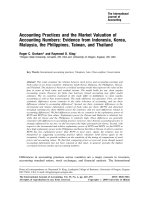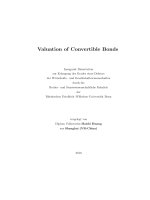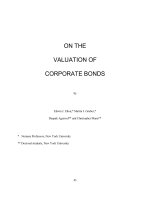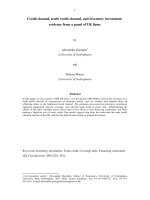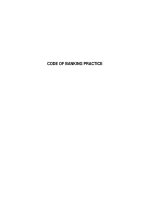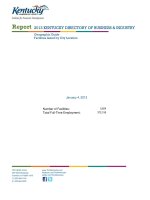Valuation of Non-marketed Goods pot
Bạn đang xem bản rút gọn của tài liệu. Xem và tải ngay bản đầy đủ của tài liệu tại đây (175.16 KB, 26 trang )
© Harry Campbell & Richard Brown
School of Economics
The University of Queensland
BENEFIT-COST ANALYSIS
BENEFIT-COST ANALYSIS
Financial and Economic
Financial and Economic
Appraisal using Spreadsheets
Appraisal using Spreadsheets
Ch. 12: Valuation of Non-marketed Goods
We have seen how in conducting efficiency benefit-cost
analysis we often use market prices, either directly or
indirectly, to value or cost project outputs or inputs.
We use market prices directly when they are generated by
perfectly competitive markets - markets that are not
distorted by monopoly, monopsony, taxes or regulations.
We use market prices indirectly when we adjust them to
generate shadow-prices. In this way prices that are
generated in imperfectly competitive markets can provide
information that can be used in the BCA.
For some project inputs or outputs there will be no market
in which they are traded, and hence no market price is
available for use either directly or indirectly in the BCA.
Some examples of non-marketed outputs or inputs:
- recreational fishing
- a nice view
- air or water pollution
- a life saved
- a disease prevented
Non marketed goods and services are just as relevant to
economic welfare as marketed commodities.
Since changes in the quantities of non-marketed goods and
services affect the level of economic welfare, they need to
be valued in efficiency and referent group BCA ( but not
in project or private BCA).
The analyst is very likely to encounter the problem of
valuing non-marketed commodities in BCA. Why?
Because project outputs or inputs do not have market prices
the market resource allocation may not be efficient. For
this reason governments see a need to regulate the private
market or undertake public expenditure in areas neglected
by the market.
The very fact that the government wants a BCA suggests
that there may be non-marketed commodities involved.
Why are some outputs or inputs that affect the level of
economic welfare not marketed?
The market is a vehicle for trade in commodities. For trade
to occur, property rights in the commodities have to be
reasonably complete and enforceable. Buyers may not be
willing to pay for an output or input unless they believe
they will have full and exclusive use of it for a specified
period of time, and will be able to sell it to someone else,
if they wish. Commodities that have these characteristics
are termed private goods.
Public goods are goods which lack some of the property
rights characteristics of private goods, and as a consequence
are not supplied in efficient levels by the private market.
It is best to think of any given commodity as lying in some
continuum between a pure private good and a pure public
good.
A pure public good is one that has the following
characteristics:
1. Non-rivalry in consumption: this means that consumption
of a unit of the good by one individual does not preclude
other individuals from simultaneously consuming that unit.
2. Non-excludability by producers: this means that supplying
a unit of the good to one person means that everyone can
consume that unit if they choose to;
3. Non-excludability by consumers:this means that supplying
a unit of the good to one person means that everyone will
consume that unit whether they wish to or not;
A semi-public good has one or two of the three pure public
good characteristics. Examples:
1. Non-rival in consumption and non-excludable by
producers: free-to-air broadcasting.
2. Excludable by both producers and consumers but non-
rival in consumption: an uncongested motorway
3. Excludable by producers, but non-excludable by
consumers, and non-rival in consumption: some
kinds of air pollution.
4. Rival in consumption but non-excludable by producers:
an open-access fishery.
External effects are flows of goods or bads that are
generated by the market economy, but are not traded
in the market.
Some externalities are private in nature - one agent’s
activity affects the welfare of one other agent eg. your
neighbour’s tree shades part of your garden. This kind
of issue can often be resolved through negotiation.
Many externalities are public in nature - they are public
goods or bads eg. air and water pollution.
Why do we expect to see more public bads than public
goods?
Excludability is largely a matter of cost. This means that to
some extent producers can decide whether to limit
availability of the good or bad they produce. It is in
their interests to limit availability of goods (which
they can charge a price for) but not to limit availability
of bads (from which they can derive no benefit).
Examples:
1. At some cost TV stations can limit access to their
services by accessing cable networks.
2. If a carbon tax is introduced it will be in producers’
interests to reduce carbon emissions
In summary, the private market does not supply efficient levels of goods or bads
which are non-excludable and/or non-rival. Provision of public goods is one of the
important activities of governments, and is one of the reasons for social benefit-cost
analysis: proposed government programs or projects which supply public goods need to
be appraised. Furthermore, because many private projects produce non-excludable
external effects it cannot be assumed that because they are in the private interest of
their proponents they are also in the public interest. Social benefit-cost analysis is used
to appraise such projects from a public interest viewpoint before they are allowed to
proceed. To be of use the social BCA needs to be able to assess the project’s external
effects in terms commensurate with its private net benefits. Thus the market failure
which provides the major rationale for social BCA at the same time poses one of its
major challenges - that of valuation in the absence of market prices.
Benefit-Cost Analysis: financial and economic appraisal
using spreadsheets, Chapter 12, p. 263
In order to illustrate the use of non-market valuation
techniques we will use environmental goods and services
as an example.
Figure 12.1
Total economic value of coral reef ecosystems
Total economic value
Direct use values
Consumptive uses
•
Coral mining
•
Shell collection
•
Fishing
Non-consumptive uses
•
Scuba diving
•
Recreation
Indirect use values
•
Storm surge protection
•
Wastewater treatment
•
Fish nursery area
•
Food chain
Option values
•
Direct use
•
Indirect use
Existence value
•
Biodiversity
•
Recreational
amenities
Bequest value
•
Biodiversity
•
Recreational
amenities
In benefit-cost analysis we are not interested in the total
value of environmental assets, but rather in the likely
changes in total value as a result of a proposed project ie.
the project either increases the annual value derived from
the reef by some amount (a project benefit), or it decreases
the annual value of the reef by some amount (a project cost).
Since the services of a coral reef are not traded in a market
(because of their public good characteristics) the benefit-
cost analyst needs to employ non-market valuation
techniques to place dollar values on changes in the flow
of services generated by the reef.
Dollar values are required to make the benefits or costs
associated with environmental changes commensurate with
the other project benefits and costs.
Economists generally base non-market valuation techniques
on the analysis of supply or demand.
Supply-side analysis: this approach generates values based
on the costs of either preventing or not preventing
environmental damage. We will look at three approaches:
- the dose/response method
- the opportunity cost method
- the preventative cost method
Demand-side analysis: this approach generates values
based on consumers’ willingness-to-pay for environmental
services. There are two main approaches:
- the revealed preference approach
- the stated preference approach
The dose/response method
Environmental attributes such as water quality and reef
area enter into the production functions for goods and
services. For example, the production function for
commodity i might be:
X
i
= f
i
(K
i
,L
i
,M
i
,Q
i
,A
i
)
where X is the annual output flow, K,L, and M represent
the annual input flows, and Q and A represent water quality
and reef area in the region in which production takes place.
A change in water quality or reef area (as a result of a
proposed project) will cause changes in the level of output
of X and possibly in the levels of the inputs K,L and M.
Example of the dose/response method: a project to increase
sugar production in FNQ is predicted to result in a
deterioration of water quality and a reduction in reef area
on the GBR. The result will be to reduce the net value of
the tourism and fishing industries. The net value is
calculated as the change in value of output less the change
in the cost of the inputs K,L and M.
Clearly the dose/response method can be applied only to
those use-values of the environment which are generated
by the market system. It cannot be used to estimate non-use
values, or to account for non-marketed use-values, such as
private (ie. non-commercial) recreation.
The opportunity cost method
This method calculates the cost of preventing or limiting
environmental damage by either not undertaking or
modifying the proposed project. Thus the opportunity cost
could take the form of forgone project net benefits, or of
additional project costs.
Once this information has been calculated it is left to the
decision-maker to judge whether the benefits of preventing
or limiting the environmental damage are large enough to
justify the cost.
A threshold analysis calculates the minimum value the
environmental values would need to take to justify forgoing
or modifying the project to prevent or limit the
environmental damage associated with the project.
The preventative cost method
This method assumes that the value of the environmental
resource is equal to the cost of preventing or mitigating the
environmental damage, or replacing or restoring the
environmental asset (the replacement cost method), or
relocating the environmental activity.
The replacement cost method is sometimes used in legal
processes to estimate damages.
It can be seen from Figure 12.2 that the preventative or
replacement cost method can overstate the extent of
environmental losses and lead to excessive levels of
environmental protection.
The preventative or replacement cost methods might be a
reasonable approach if private individuals or groups were
observed to be willing to incur these costs.
Figure 12.2 Measures of Value using the Replacement Cost Method
Restoration Level
100%
Q
L
Q
e
0%
A
$
Restoration Costs (C)
Restoration
Benefits (B)
Net Benefits
Demand-side methods of environmental valuation
Revealed preference approaches infer environmental
values from observed consumer behaviour eg. :
- travel cost method (TCM)
- random utility model (RUM)
- hedonic pricing model (HPM)
Stated preference approaches estimate environmental
values by asking consumers what they are willing to
pay for the preservation of environmental assets eg.:
- contingent valuation method (CVM)
- discrete choice modeling (DCM)
The travel cost method (TCM)
By observing consumer behaviour in the market for travel
(a related market) to and from a recreational site we can
estimate the annual consumer surplus generated by that site
for its users.
Example: two consumers have the same income, tastes, and
face the same set of prices, except the cost of travel to a
recreational site. This means they have the same demand
curve for the services of the site. One consumer (B) lives
further from the site and pays a higher travel cost per visit.
We observe P
A
< P
B
, and Q
A
> Q
B
. We can treat
(P
A
,Q
A
) and (P
B
,Q
B
) as points on the individual demand
curve and use the estimated curve to calculate the annual
value of consumer surplus accruing to each individual.
Figure 12.6 Approximate Individual Demand Curve for Park Visits
Price/cost
Per trip
($)
25
15
5
25
10
Number of trips per annum
20
The random utility model (RUM)
As with the TCM, the RUM uses trip data and travel costs,
together with consumer characteristics such as income
level and tastes (level of education or experience) to
analyse consumer choice among alternative recreational
sites. Unlike the TCM, which assumes the number of visits
is a continuous function of price (travel cost), the RUM is
a model of discrete choice among substitute sites.
Since the RUM takes explicit account of site characteristics
in modeling choice among sites, it can be used to value
the individual attributes of a site, and changes in site value
per trip as a result of changes in these attributes. However it
cannot be used to predict changes in the number of visits
in response to attribute changes.
The hedonic pricing model (HPM)
The hedonic pricing model (HPM) regresses observed
market prices against the levels of various attributes of a
good or service in order to place separate valuations on
these attributes. It is widely used in product design eg.: what
are consumers willing to pay for each of the individual
attributes of a car - automatic transmission, air conditioning,
air bags, anti-lock brakes etc.?
Using the HPM house price data can be used to value
local environmental assets such as air quality or city parks.
The hedonic price function is expressed as:
P
i
= f(S
i
, N
i
, Q
i
)
where S
i
= house and site characteristics, N
i
- neighbourhood
characteristics, Q
i
= environmental quality characteristics,
and i = 1…n is a cross-sectional sample.
The contingent valuation method (CVM)
The contingent valuation method (CVM) proceeds by asking
people what they would be willing to pay for the services of
the particular environmental asset in question. It has the
advantage of applying to both use- and non-use values. Its
disadvantage is the possible presence of various kinds of
bias in the results of the survey, including:
- hypothetical market bias - respondents are not
really paying for the services in question;
- strategic bias - respondents try to influence the
outcome of the study;
- design bias - the way the questions are phrased,
particularly the form of the notional payment
vehicle, can affect the results.
Discrete choice modeling (DCM)
Discrete choice modeling (DCM) asks people to value a
range of options (unlike CVM which values a single option
relative to the status quo). The options may consist of
various types and levels of environmental protection as well
as levels of more conventional forms of economic activity,
such as jobs. The survey results can be used to calculate
trade-offs between various types and levels of protection
and other economic values. Marginal values of types of
environmental protection can also be calculated and used to
work out the relative value of each policy option.
An advantage of DCM is that it may be less prone to bias
because of its focus on choice among alternatives. A
disadvantage is that there is no rule governing the range of
possible alternatives or the possible level of each.
